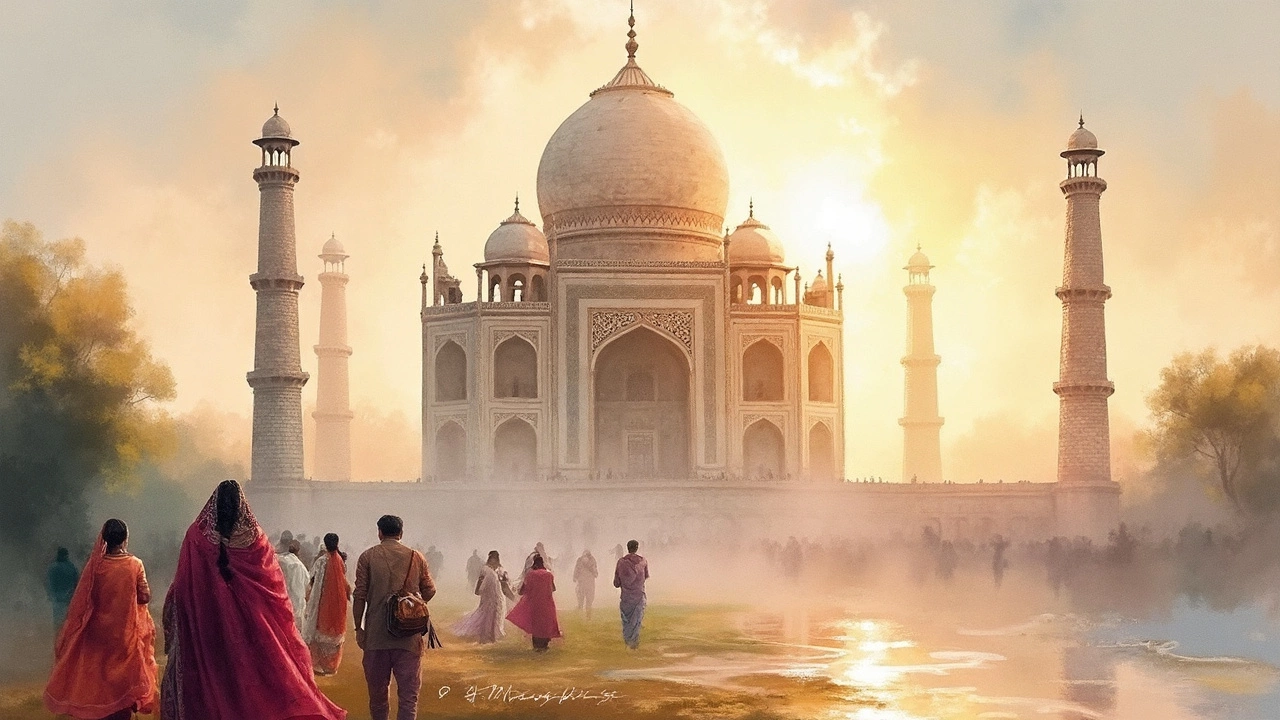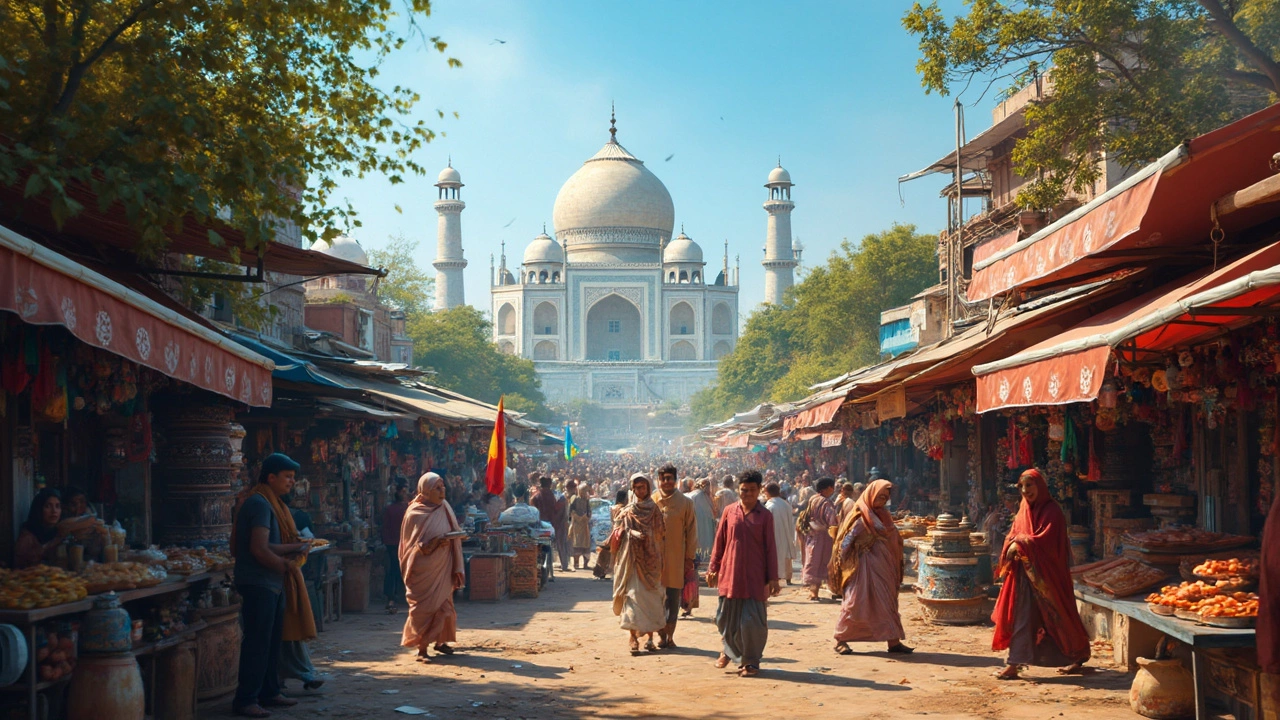Is the Taj Mahal in Northern or Southern India? Uncovering Its True Location
 Apr, 11 2025
Apr, 11 2025
Alright, anyone planning a trip to India can't skip out on the Taj Mahal. It's like the Eiffel Tower for us, but with a lot more history and fascinating stories. One question pops up often – where exactly is this iconic beauty? Northern or southern India? Well, let’s clear that up right away. The Taj Mahal is in northern India, specifically in Agra, Uttar Pradesh.
Agra is a pretty neat place. Not just because of its famous marble facade but also for its bustling streets and rich Mughal history. It's around 230 kilometers from Delhi, which makes it quite accessible if you’re already exploring the capital. Hop on a train, a bus, or even a car, and you'll be staring at the Taj in a matter of hours. Keep reading to learn more about why this location is not just random but significant.
Discovering the Location
Okay, if you're trying to find out where the Taj Mahal is hiding, you're not alone. This legendary structure is placed right in Agra, a city in the state of Uttar Pradesh up in northern India. It's one of those places that every traveler dreams of seeing up close at some point.
Agra sits around 230 kilometers southeast of Delhi, which is super helpful if you're planning a trip from the capital. You can hop on the express train from Delhi, and in about two hours, you’ll hit Agra. Pretty convenient, right? Also, if you like road trips, the Yamuna Expressway is a smooth drive and offers a chance to see the countryside.
But why is Agra so special for housing the Taj Mahal? Well, it used to be a thriving Mughal capital. Shah Jahan, who built the Taj in the 17th century as a love letter (alright, more like a mausoleum) for his wife Mumtaz Mahal, chose this spot for its access to materials and skilled artisans.
The Taj Mahal, a UNESCO World Heritage Site, gets tons of visitors every year. Agra is buzzing during the peak seasons, typically from October to March, when the weather is just right—not too hot, not too rainy. This makes it the perfect time to soak in all the history without melting in the sun.
Here’s a little nuggets of wisdom: if you're looking to dodge the crowds and get that perfect snap, aim for early morning visits. The sight of the sunrise reflecting on the pristine white marble is totally worth the early wake-up call. Plus, you’ll have some breathing room to take it all in without a thousand other people photobombing your shots.
A Brief History
Alright, so how did this magnificent Taj Mahal come to be? The story goes back to the 17th century. Built by Emperor Shah Jahan, the Taj Mahal was a labor of love dedicated to his favorite wife, Mumtaz Mahal, who died during childbirth. This grand gesture aimed to honor her memory in the most spectacular way possible.
Construction started in 1632 and took about 22 years to complete. Imagine working on something that intricate for that long - that's some serious commitment! Over 20,000 artisans from across India, Persia, and the Ottoman Empire contributed to this masterpiece. It's not just the scale that's impressive, but the attention to detail and craftsmanship will blow your mind.
The design of the Taj Mahal is an incredible blend of Indian, Persian, and Islamic architectural styles. The use of white marble makes it stand out, and the precise inlay work of semi-precious stones adds an extra layer of elegance. It’s one thing to see pictures and another to witness it in person.
If you're curious about the numbers, here's a quick snapshot:
| Year Built | 1632-1653 |
|---|---|
| Labor Force | Over 20,000 artisans |
| Architectural Influence | Indian, Persian, and Islamic |
One more amusing tidbit - Shah Jahan had plans for a 'black Taj Mahal' across the river from this iconic site to serve as his own tomb. Well, that never happened, allegedly due to family drama, but it adds to the mythical charm surrounding the place.
Understanding a bit of the past gives so much more meaning when you stand in front of this stunning mausoleum. So, put Agra on your must-visit list when exploring North India.

Travel Tips
So, you're getting ready to see the Taj Mahal? Awesome choice! Let me give you some insider info to make your trip smooth and memorable. First off, the best time to visit is from October to March when the weather is cooler, and you can enjoy that stunning sunrise or sunset view without frying in the sun.
Getting there is half the adventure. If you're coming from Delhi, it’s a breeze. You’ve got loads of options like the Gatimaan Express, which is a super-fast train, or even private taxis that can give you more flexibility with your itinerary. Want to go budget-friendly? You can always opt for buses too.
Now, let’s talk about ticketing. You’ll want to grab your entry tickets online, if possible. It saves time and energy that you’d rather spend gazing at the breathtaking marble work. Trust me, the line at the ticket counter can be longer than you'd think. Remember, the Taj is closed on Fridays, so plan around that!
Once inside, there are a few rules to respect. No tripods, drones, or large bags are allowed. Security is tight but in a good way to keep everyone safe and the site pristine. Pack light and just enjoy the moment. Oh, and a pro tip: wear comfy shoes! You’ll be doing a lot of walking, and the marble isn’t exactly sneaker-friendly.
Need food? Agra is full of delightful street food and restaurants. Try some authentic Mughlai dishes like butter chicken or petha, a sweet treat that’ll leave you wanting more. A little word of caution though: street food can be spicy, so if you’re not used to it, have some water handy.
Mornings are quieter, giving you that serene experience you’re probably looking for. If you’re there for photography, catch the reflection on the Yamuna River during sunrise. It’s a view you won't soon forget!
| Travel Option | Duration from Delhi | Cost (Approx) |
|---|---|---|
| Gatimaan Express | 100 minutes | INR 750-1500 |
| Private Taxi | 3-4 hours | INR 2500-4000 |
| Bus | 4-5 hours | INR 500-800 |
These tips should set you up for an unforgettable trip to see the Taj Mahal. Enjoy every moment and be sure to take lots of pics!
Nearby Attractions
When you're done gazing at the majestic Taj Mahal and capturing a million photos, know that there’s a whole lot more to explore around Agra. Seriously, you’ll want to stick around.
First up, just a hop, skip, and a jump away is the Agra Fort. This UNESCO World Heritage site is a massive red sandstone fortress that whispers the past tales of Mughal emperors. Walking through its grand gates, you’ll stumble upon exquisite palaces, halls, and mosques, each with a unique story to tell.
If palaces are your thing, check out Fatehpur Sikri, approximately 40 kilometers from Agra. It’s another gem, with its stunning red sandstone buildings and a rather fascinating architectural style. Built by Emperor Akbar, this city was once the capital of the Mughal Empire, though not for long. Still, its stunning beauty remains intact, making it a must-see.
For something a tad different, head to the Mehtab Bagh. This garden is right across the Yamuna River from the Taj Mahal and offers a picture-perfect view. Imagine catching that perfect sunset with the Taj as your backdrop. It’s also much less crowded, so you can enjoy a peaceful moment away from the hustle and bustle.
Other spots to add to your list include the Tomb of Itimad-ud-Daulah, also called ‘Baby Taj’. This charming little mausoleum is often overshadowed by its grander neighbor, but its detailed design and marble work are definitely worth seeing.
Here’s a little bonus tip: Agra is known for its local crafts, especially marble inlay work. Take a stroll through the local markets for souvenirs to remind you of your trip. From mini Taj replicas to delicately crafted marble art pieces, your options are endless!
So, there you have it, just a taste of what's nearby when you’re done visiting the Taj Mahal. Each site adds a new layer to your journey through northern India!